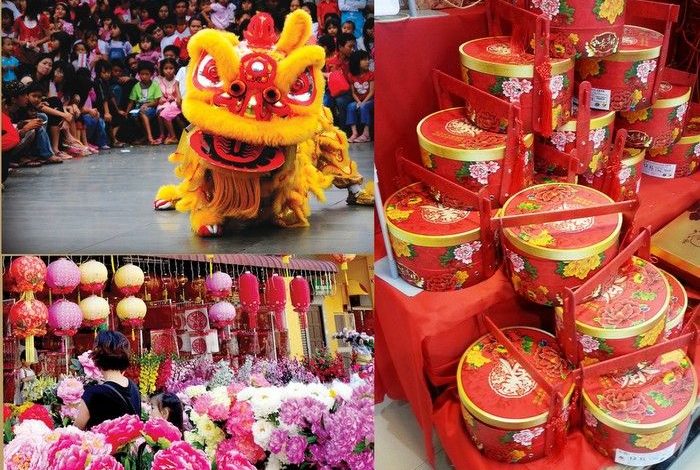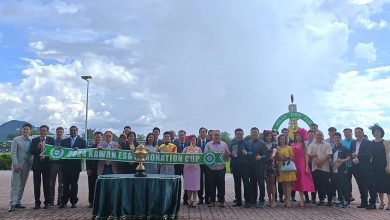Chinese New Year: A Look into Customs and Traditions


Cover Story
By Yvette Yeow
“Gong Hey Fatt Choy!” will soon be all that you hear as the month approaches one of the most important festive celebrations for the Chinese all around the world. The month of February marks this year’s Festival of Spring or better known as Chinese New Year. And with just a few more days remaining before the celebration, Ipoh Echo would like to bring its readers on a brief tour of the customs and foods served during Chinese New Year.
Respectful Rituals and Specialty Dishes Join Hands in 15 Days of Celebration
Although the origin of Chinese New Year is lost in the mists of time, it is commonly known amongst Chinese that it started out with a terrible mythical monster that preyed on villagers. The lion-like monster’s name was ‘Nian’ which is also the Chinese word for ‘year’. A wise old man counselled villagers to use the colour red and firecrackers to chase away the Nian and this is now a significant part of the festival. On the anniversary of the date, the Chinese recognise the ‘passing of the Nian’ known in Chinese as guo nian which is also synonymous with celebrating the New Year.
Chinese New Year celebrations lasts 15 days, with each day having its own significance with its own different customs and celebration methods. The first day of Chinese New Year is for the welcoming of deities or gods. It is a tradition to light firecrackers to ward off evil spirits. Vegetarianism is also practised on that day for longevity, especially amongst Buddhist families and to seek pardon and forgiveness from their gods. The second day of Chinese New Year is known as Hoi Nin where family and friends would go around visiting each other, continuing throughout the 15 days.
The seventh day of New Year is also known as Yan Yat which means everyone’s birthday. Raw fish and porridge is usually eaten on that day to symbolise continuous wealth and prosperity. One of the famous dishes for that day is tossing the Yee Sang where family members and friends would gather around a table with their chopsticks ready to toss the dish and the higher you toss it the higher your luck would be throughout the year.
The eighth day of the celebration is an important day especially for the Hokkien Chinese. It is the day where all family members would come together for another reunion dinner and pay their respects to the Tian Gong, or the God of Heaven, at midnight. Hokkiens would prepare a table full of food as offerings to the Tian Gong showing gratitude for his blessings.
The fifteenth day of the Chinese New Year marks the last day of the celebration and is also known as the Yuan Xiao festival or Chap Goh Mei. On that day, rice dumplings such as Tang Yuan (glutinous rice balls served in a sweet soup) are eaten. It is also a day celebrated by singles seeking a romantic partner, much like the popular Valentine’s Day. Single ladies would usually write their contact number on a tangerine and toss it into a river, while men would collect them and eat the oranges. The taste is an indication of their possible love: with sweet representing a good fate while sour, a bad one.




‘Ang Pau’ or Red Packets
Another symbolic custom of the 15-day celebration is giving out Ang Pau or red packets. Family members or friends that are married are required to give out red packets to those who are younger and single. The tradition of giving out red packets was a practice of giving out blessings and luck; it is also customary and polite for the receiver to wish the giver a happy new year and a year of happiness, health and wealth before accepting the red packet. A simple practice known as Cham Cha is also carried out amongst some Chinese families when giving and accepting red packets. Cham Cha is an act of presenting a cup of tea to the elders before accepting the red packets. Usually the Cham Cha ceremony is carried out in the morning of the first day of Chinese New Year as an act of respect towards the elders.
Traditional Foods of Chinese New Year


“Chinese New Year has always been such a joyous celebration for me. I especially love it when everyone would just travel back to Ipoh for the reunion dinner, and we could meet and talk about anything over good food. One of the main dishes for our family during the reunion dinner is the Fat Tiu Chiong (literally translated as ‘Buddha Jumps over the Wall’) also known as ‘Buddha’s Temptation’. This dish is one of my late father’s favourites and is also the most complex of all dishes made during the dinner. It consists of up to almost 10 ingredients including chicken, Chinese mushrooms, bamboo shoots, abalone, pork, fish maw, scallops, sea cucumber and shark’s fin, and requires a lot of work requiring two days to finish,” she emphasised.
According to her family’s recipe, the broth of the ‘Buddha’s Temptation’ is required to be prepared a day before. A whole chicken and pieces of pork would be boiled for a strong broth. Some of the ingredients found in the dish would also have to be prepared beforehand, such as the abalone, shark’s fin and sea cucumber. These ingredients have to be cleaned and cooked until it softens up before adding into the broth. Sometimes this process would begin up to a week before. Slices of ginger would also be added into the broth to prevent any fishy taste.


‘Cham Cha’ or Tea Ceremony
“Our family also practises the Cham Cha ceremony on the morning of the first day of Chinese New Year. My children especially would present me a cup of tea first thing in the morning and would wish me a prosperous new year before accepting their red packets,” she added.
Madam Yoke Wah also shared with Ipoh Echo some of her favourite dishes that were once prepared by her family for the reunion dinners. One of her favourites was the arrowhead cooked with chicken. The dish is a much lighter dish compared to the ‘Buddha’s Temptation’ that is rich in protein and calcium. It is also a very simple dish tossed in a frying pan with finely cut arrowheads, chicken cut into cubes and mushrooms.
Rice cakes and other confectionery such as pineapple tarts and Kuih Kapit (‘love letters’) are also presented as snacks for guests during their visits. Chinese believe that food should always be offered to their guests and that it is impolite to have insufficient food when your guests are present. However, snacks are varied depending on the religious practices and regional ethnicity of the Chinese family. Tangerines are also offered to guests or treated as gifts during visits.




Caution in Celebration
Chinese New Year is a rich celebration filled with different customs and traditions that are distinctive and uniquely Chinese. From age old traditions such as giving out Ang Pau to recent practices such as tossing out tangerines on Chap Goh Mei, the New Year celebration is most certainly a festival to look forward to. Before going on a shopping spree or being caught up with last minute decorations, Ipoh Echo would like to urge readers to be careful on the road. Be it long distance travelling or a short trip to your local department store, always be cautious when driving as accidents are more prone during festive seasons.
Ipoh Echo wishes all a happy prosperous Chinese New Year and do remember not to overeat!


